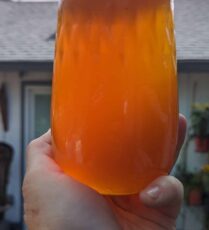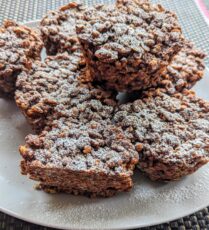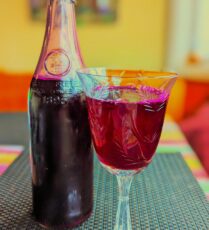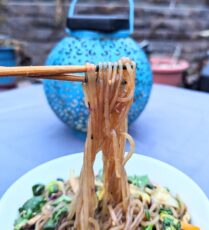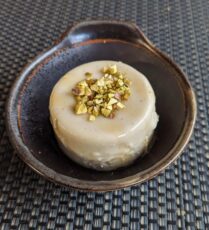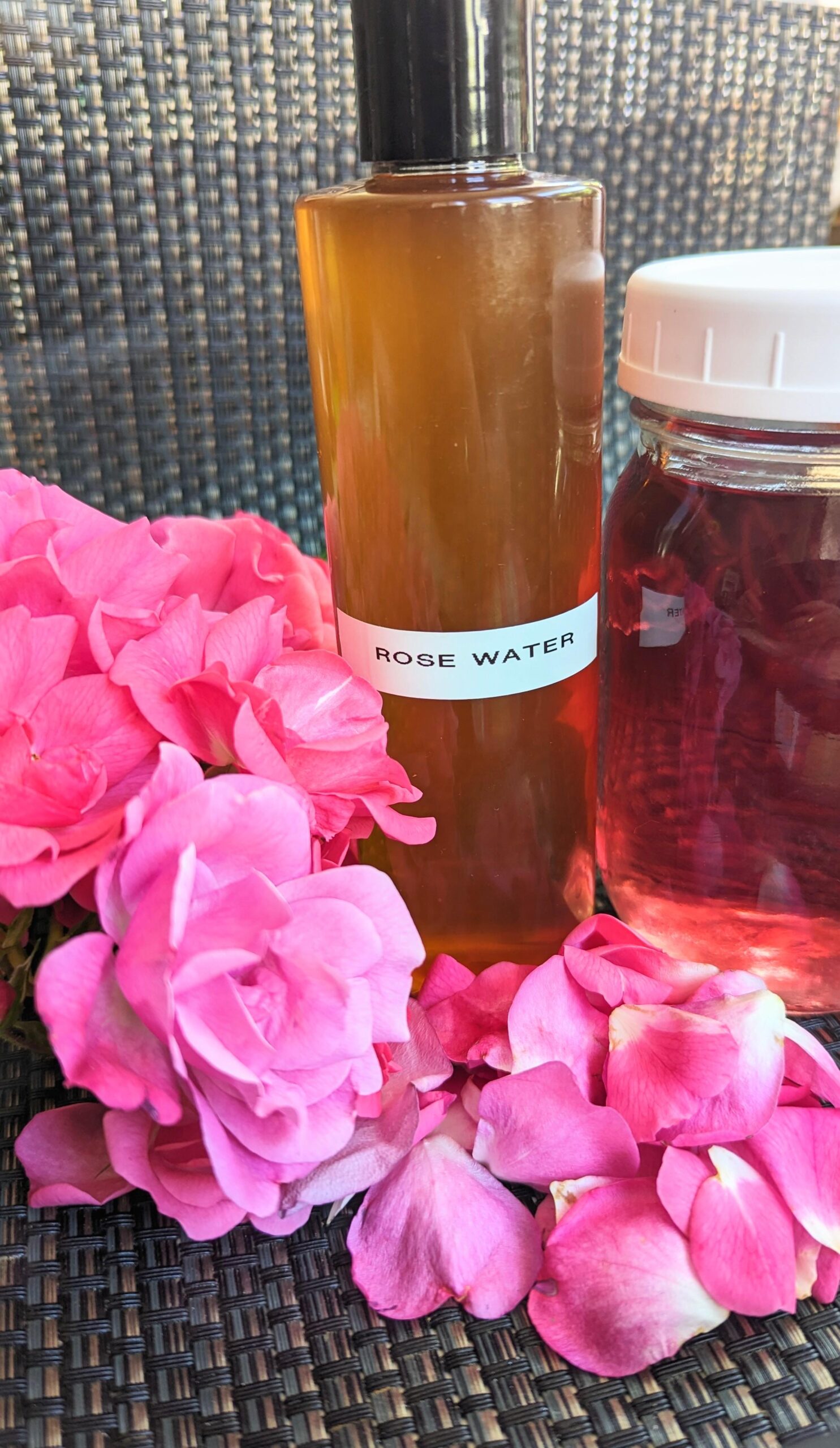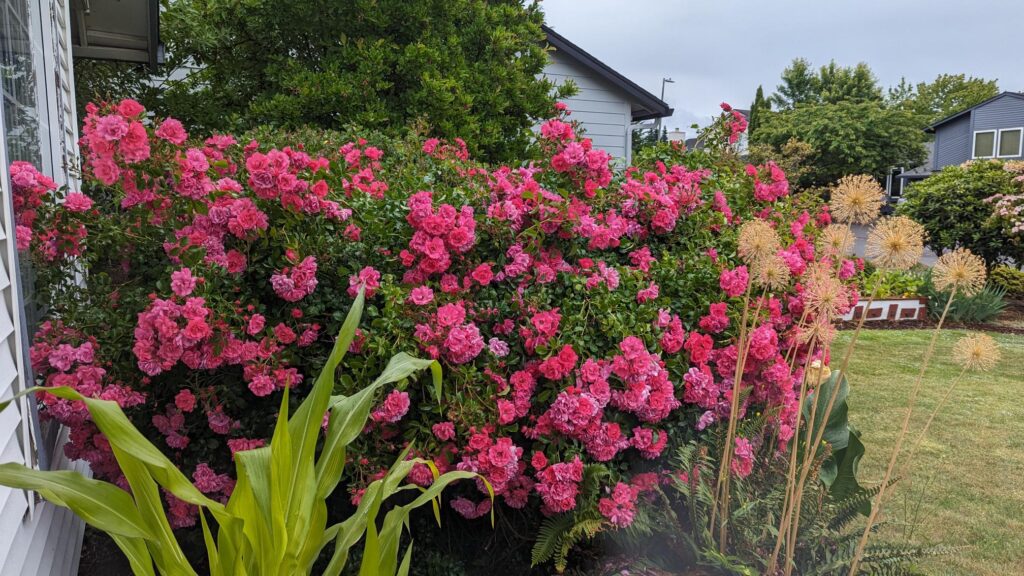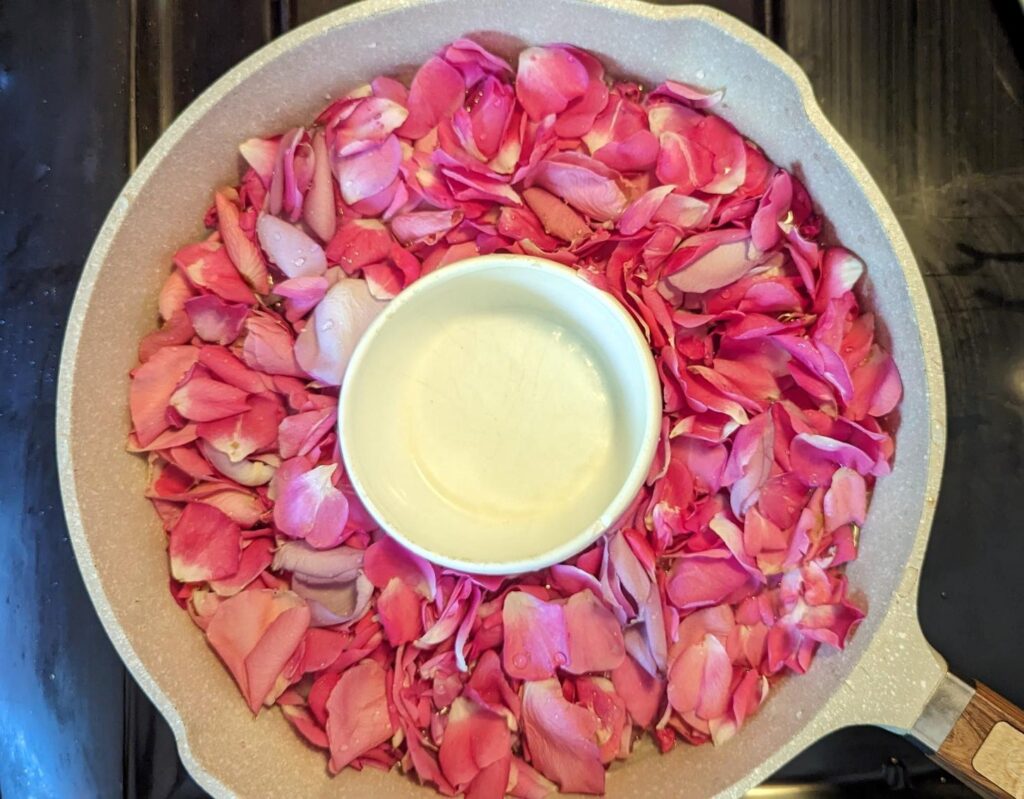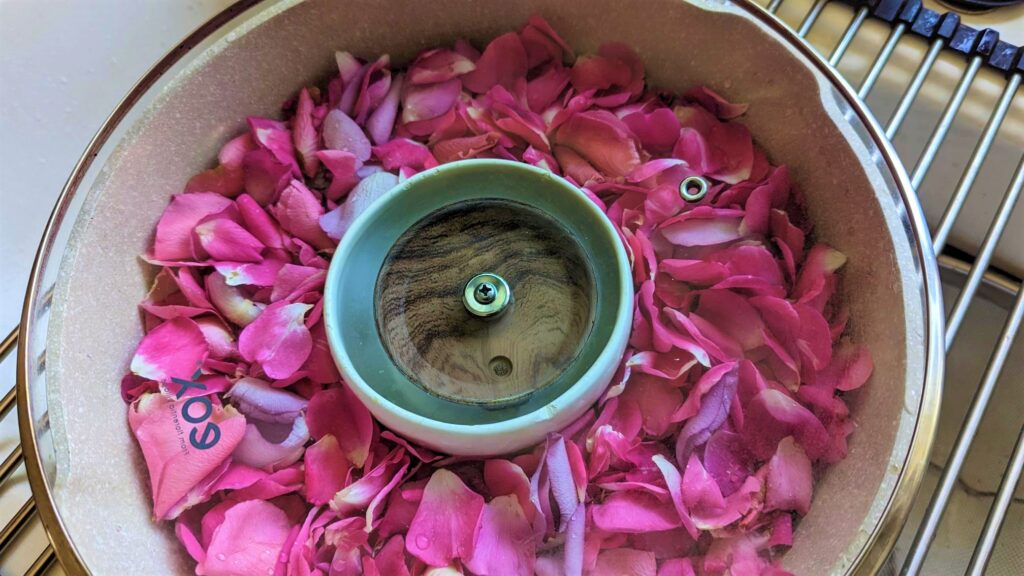I can still remember today the scent of rose water my grandmother used to spray on her face every night before going to bed! It was such a delicate floral sweetness! After my grand father passed away (peacefully while watching tv), my parents thought that she wouldn’t be as lonely if I spent several nights a week with her. So I did, and they were right! We would brush our teeth together and she always sprayed some rose water on her face and sometimes on mine too! I have still have fond memories of our time together.
Fast forward 40+ years, when we moved into our house in the Pacific Northwest that has a large rose bush in the front. And every year, after displaying its glorious blooms, all the petals end up carpeting the ground. A lot of them! So this year, I thought to myself, why not collect them and make some rose water. This particular rose bush isn’t very fragrant but it is abundant and organic!
I always thought that all essential oils and rose water were obtained thru a long process of distillation. But I did a little research and it turns out, you can make rose water without any expensive or special equipment. I was off a good start. I sometimes get ideas and can get a little over my head but this one seems feasible!
Benefits and uses of rose water
My grandma was right, rose water is amazing for the skin. It is rich in antioxidants, it soothes skin irritation, reduces redness, puffiness, heals scars, and relieves headaches. Now that I know how to make it, I use it as a face wash and toner by using a small spray bottle in the morning and sometimes at night. It immediately makes you feel smooth and refreshed. You can leave it on for 15-20 minutes before washing it off. Half the time I don’t even bother removing it. My skin feels so soft! You can add some glycerin to transform rose water into a natural moisturizer.
But the benefits don’t stop with the skin, rose water can help prevent hair loss and help re-growing hair (just rub some rose water into your scalp several times a week). You can also use it as a mild shampoo and conditioner. Leave it on for 10-15 minutes before rinsing.
For women, rose water can help soothing menstruation cramps, lifting moods. It can be applied anywhere, including private parts to soothe any rash or irritation.
Because of its ability to clear toxins from the body, and curb our appetite, rose water can even help with weight loss. How about that?
Did you know that homemade rose water can be added to hot or cold drink? Check out my Persian mocktail recipe or to deserts like a rose cardamom rice pudding. Rose water purchased in Asian or Middle Eastern stores or online is more concentrated than homemade water so use sparingly.
Making rose water
Now the fun starts and we can get down to business! It is best to use petals from organic roses. The more fragrant the rose the more scented the water will be.
- Simmering method (simple and easy)
Pluck the petals and remove any debris or damaged petals. You can quickly rinse them to do that.
In terms of quantity, 2-3 roses will yield about 1 cup of fresh petals. You can also use 1/4 cup of dried petals.
Place the petals in a wide pan and pour a little distilled water over the fresh petals, just enough to cover them. Don’t put too much water as it will dilute your water. Use 1/2 gallon of distilled water for 2-3 cups of fresh petals.
Simmer covered for 40-45 minutes (when the petals will have become transparent, it is done).
Turn off the heat and let it cool down with the lid on.
Sterilize a glass container or spraying bottle. Filter and pour the rose water.
If you compost, add the petals to your pile!
2. Distilled method (extra step)
There is a simple way to distill the rose essence without using an expensive complicated distiller. This method takes the same amount of preparation and time but you will also need a small heat proof bowl and some ice.
Using a wide pan, place a heat proof bowl in the middle and add the petals all around. Add enough distilled water to cover the petals. Place the lid upside down so that the knob is now facing down into the bowl.
Place some ice cubes in the lid and bring to a boil. As soon as it starts to boil, turn down and simmer for 40-45 minutes, making sure to replace the ice cubes as they melt. When the petals have lost all their colors, it is done. Turn off the heat and let it cool down.
Carefully remove the lid without burning your fingers. Filter and pour into clean glass bottle. This rose water can last up to 6 months away from direct sunlight.
Notes on the process
I have tried both techniques and noticed that the distilled method produced less water. To my surprise, the liquid was totally clear, with no pink tint. I first thought that something had gone wrong but apparently, that’s normal. It also took 5-10 minutes longer. The good news is that you can also use the liquid that was simmering around the bowl and make more rose water that way.
Personally, I prefer the simmering method because it is simpler, it produces more water, it always has a nice pink tint that will vary depending on the type of petals you use. On one of the last batches I made I used petals from darker roses were bought and the liquid was even deeper red.
Shelf Life & Storage
Rose water never really goes bad but it will loose some of its potency over time. One way to preserve it longer is to add 2 teaspoons of alcohol for each 2 cups of distilled water (like vodka or grain alcohol) to the simmering water. The simmer method produces a more volatile water that should be used in a month while the distilled rose water has a longer shelf life of 6 months.
Store your rose water into a glass bottle (clear or tinted) and away from direct sunlight. You can refrigerate if you want but it isn’t necessary. Now that you know how to make it, you can treat and indulge yourself in this ancient ritual that will cost you nothing! It also makes a great gifts. So all you have to do is find some cute glass spray bottles!



